Installing marble countertops in your bathroom can transform the space into an elegant and luxurious retreat. Marble, with its classic veining and timeless beauty, has been a favored material in architecture and design for centuries. However, installing marble countertops requires careful consideration of various factors, including selection, preparation, and maintenance to ensure the long-term beauty and functionality of the stone.
One of the first steps in installing marble countertops in your bathroom is selecting the right type of marble. Marble comes in a variety of colors and patterns, from the classic white Carrara marble with its soft gray veining to the more dramatic Calacatta marble, known for its bold and striking veins. When choosing marble, it’s essential to consider not only the aesthetics but also the durability and maintenance requirements. Some marbles are more prone to etching and staining, so understanding these characteristics can help you make an informed decision.
Once you’ve selected your marble, precise measurements of your bathroom countertop space are crucial. Accurate measurements ensure that the marble slab is cut to fit perfectly, minimizing waste and reducing installation time. This step often involves creating a template of the countertop area, which will be used by the fabricator to cut the marble slab to the exact dimensions needed. Any inaccuracies in measurement can lead to costly adjustments and delays.
The preparation of the bathroom area is the next critical step. This includes ensuring that the existing cabinetry and supports are strong enough to hold the weight of the marble, which is considerably heavier than other countertop materials like laminate or solid surface. Reinforcing the cabinets may be necessary to provide adequate support and prevent future issues such as sagging or structural damage. It’s also important to ensure that the surface is level and free of any debris that could interfere with the installation.

Transportation of the marble slab to your home requires careful handling to avoid damage. Marble is a natural stone and, despite its durability, can crack or chip if not handled properly. Professional installers typically handle the transportation and installation to ensure the marble arrives in perfect condition and is installed correctly. Attempting to transport and install marble yourself can be risky and may lead to costly mistakes.
When it comes to the actual installation, precision is key. The marble slab is carefully placed on the prepared surface, and adjustments are made to ensure a perfect fit. Any seams between slabs are filled with color-matched epoxy to create a seamless appearance. The installers will also use a special adhesive to secure the marble to the cabinetry, ensuring it is firmly in place.
Sealing the marble is a crucial step in the installation process. Marble is a porous material, which means it can absorb liquids and become stained. Applying a high-quality sealer helps to protect the marble from water, oils, and other substances commonly found in bathrooms. The sealer needs to be reapplied periodically, depending on the type of marble and the level of use, to maintain its protective barrier.
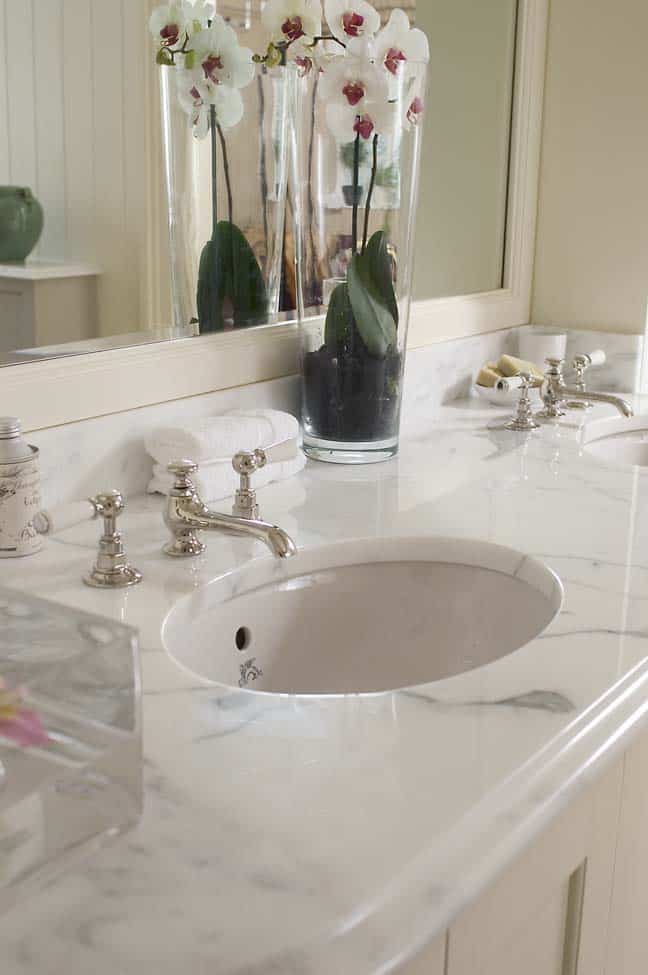
Maintenance of marble countertops in a bathroom requires regular cleaning and care. It’s important to use pH-neutral cleaners specifically designed for natural stone to avoid damaging the surface. Avoid using abrasive cleaners or tools that can scratch the marble. Spills should be wiped up immediately to prevent staining, and it’s advisable to use coasters and trays to minimize direct contact with liquids and toiletries.
Despite its need for careful maintenance, marble offers unmatched beauty and a luxurious feel that can significantly enhance the overall design of your bathroom. Its natural patterns and colors add a unique and sophisticated touch that can elevate the aesthetic appeal of the space. Additionally, marble can complement various design styles, from classic to contemporary, making it a versatile choice for any bathroom.
When integrating marble countertops into your bathroom design, it’s also important to consider the overall color scheme and materials used. Marble pairs well with a range of finishes, including polished chrome, brushed nickel, and matte black fixtures. Coordinating your faucets, hardware, and accessories with the marble can create a cohesive and harmonious look.
The longevity of marble countertops in a bathroom is another appealing aspect. When properly maintained, marble can last for decades, providing a timeless and durable surface. Unlike synthetic materials, marble’s natural beauty does not fade over time, and it can even develop a patina that adds to its charm and character.
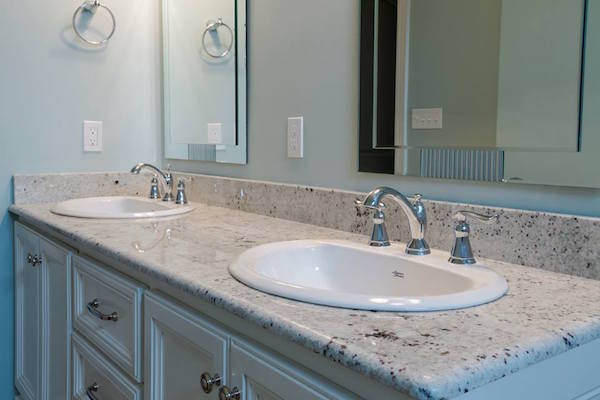
In terms of investment, installing marble countertops can add value to your home. Potential buyers often appreciate the luxury and quality associated with marble, which can make your home more attractive on the market. While marble may have a higher upfront cost compared to other materials, its long-term benefits and appeal can make it a worthwhile investment.
To further enhance the functionality of your marble countertops, consider integrating features such as built-in sinks or backsplashes. A marble backsplash can protect the walls from water damage and add a cohesive look to the bathroom design. Integrated sinks made from the same marble slab create a seamless and elegant appearance, eliminating joints and crevices where dirt and grime can accumulate.
Lighting also plays a crucial role in showcasing the beauty of marble countertops. Proper lighting can enhance the natural veining and patterns of the marble, highlighting its unique features. Consider using a combination of ambient, task, and accent lighting to create a well-lit and inviting bathroom space.
Ultimately, the decision to install marble countertops in your bathroom should be based on a balance of aesthetics, functionality, and maintenance considerations. By choosing the right type of marble, ensuring proper installation, and committing to regular care, you can enjoy the luxurious and timeless beauty of marble for many years.
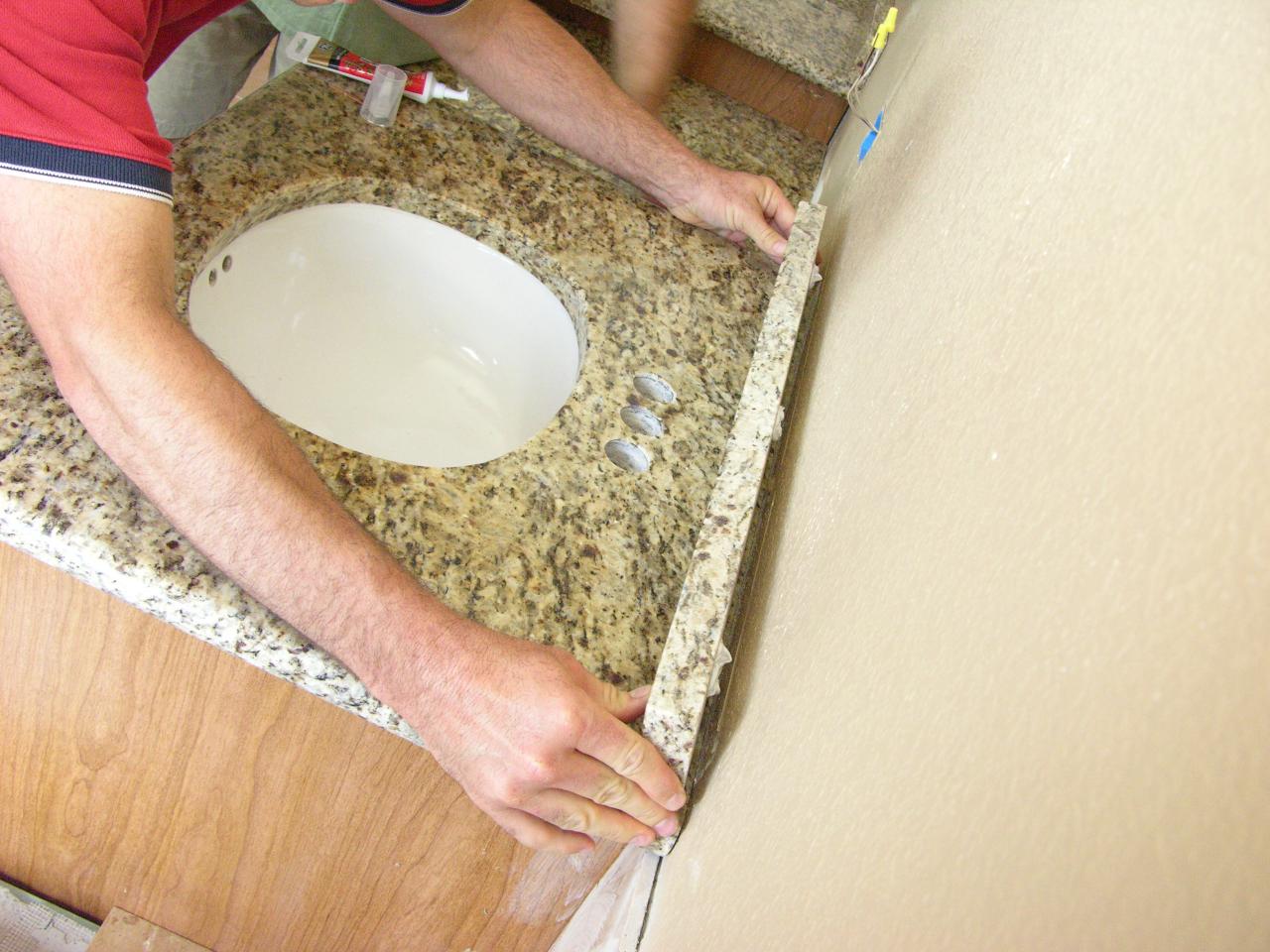
Common Mistakes to Avoid
When installing marble countertops in your bathroom, several common mistakes can compromise the project’s success. One significant mistake is failing to properly seal the marble. Marble’s porous nature makes it susceptible to staining and etching from water, oils, and acidic substances. Neglecting to apply a high-quality sealer or failing to reapply it periodically can lead to permanent damage and a diminished appearance.
Another common mistake is using inappropriate cleaning products. Harsh chemicals, acidic cleaners, and abrasive tools can scratch, etch, and dull the marble surface. Always use pH-neutral cleaners specifically formulated for natural stone to maintain the marble’s pristine condition.
Improper measurement and template creation can also lead to significant issues during installation. Accurate measurements and precise template creation are crucial for ensuring that the marble slab fits perfectly. Any errors in this stage can result in costly adjustments and delays.
Attempting to install marble countertops without professional assistance can be a costly mistake. Marble is heavy and requires careful handling and precise installation techniques to avoid damage. Professional installers have the experience and tools necessary to ensure a flawless installation.
Finally, failing to consider the weight and structural support needed for marble countertops can lead to long-term problems. Ensure that your cabinets and supporting structures are reinforced to handle the weight of the marble. Neglecting this can result in sagging countertops and potential damage to the cabinetry.

How much do marble countertops cost?
The cost of marble countertops can vary widely depending on the type of marble, its quality, and the complexity of the installation. On average, marble countertops can range from $60 to $200 per square foot, including installation. High-end marbles like Calacatta can be more expensive, while more common varieties like Carrara may be more affordable. Additional costs may include reinforcing cabinetry and preparing the surface for installation.
How often do marble countertops need to be sealed?
Marble countertops should be sealed at least once a year, but the frequency can depend on the type of marble and the level of use. High-traffic areas may require more frequent sealing to maintain their protective barrier. To test if your marble needs sealing, sprinkle a few drops of water on the surface. If the water absorbs into the marble and darkens, it’s time to reseal.
Can I install marble countertops myself?
While it’s possible to install marble countertops yourself, it’s generally not recommended due to the complexity and weight of the material. Professional installers have the expertise, tools, and experience to handle marble properly and ensure a precise fit. DIY installation can lead to mistakes, damage, and additional costs for corrections.
What is the best way to clean marble countertops?
The best way to clean marble countertops is with a pH-neutral cleaner specifically designed for natural stone. Avoid using acidic or abrasive cleaners, as these can damage the marble. For daily cleaning, use a soft cloth or sponge with mild soap and warm water. Wipe up spills immediately to prevent staining, and regularly dust the surface to keep it looking pristine.
Are marble countertops suitable for high-traffic bathrooms?
Marble countertops can be suitable for high-traffic bathrooms if properly maintained. Regular sealing, immediate cleanup of spills, and using coasters and trays to protect the surface can help preserve the marble’s beauty and functionality. However, if you prefer a lower-maintenance option, consider other materials like quartz that offer similar aesthetics with less upkeep.

Questions to Ask Before Installing Marble Counters in Your
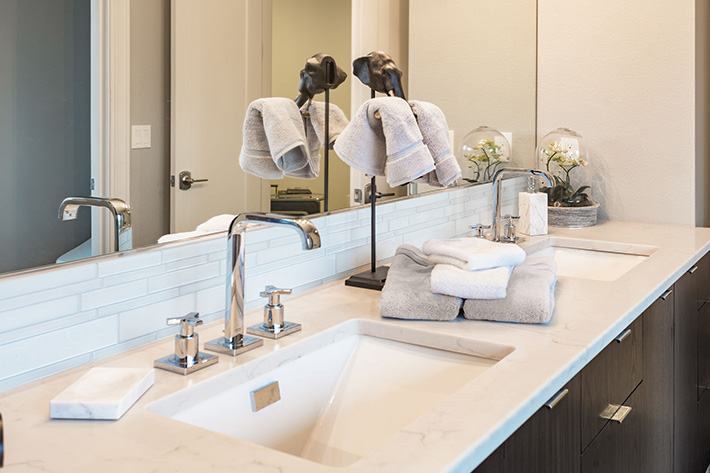
Is Marble the Right Countertop for Your Bathroom?
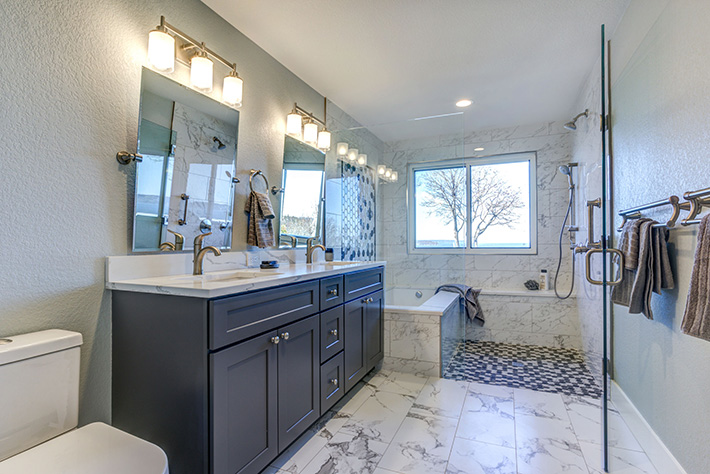
Is marble a good material for bathroom vanity countertops? The

How to Install a Bathroom Countertop how-tos DIY
![]()
How to Install a Vanity Top – Onyx Sink Top

Related articles: